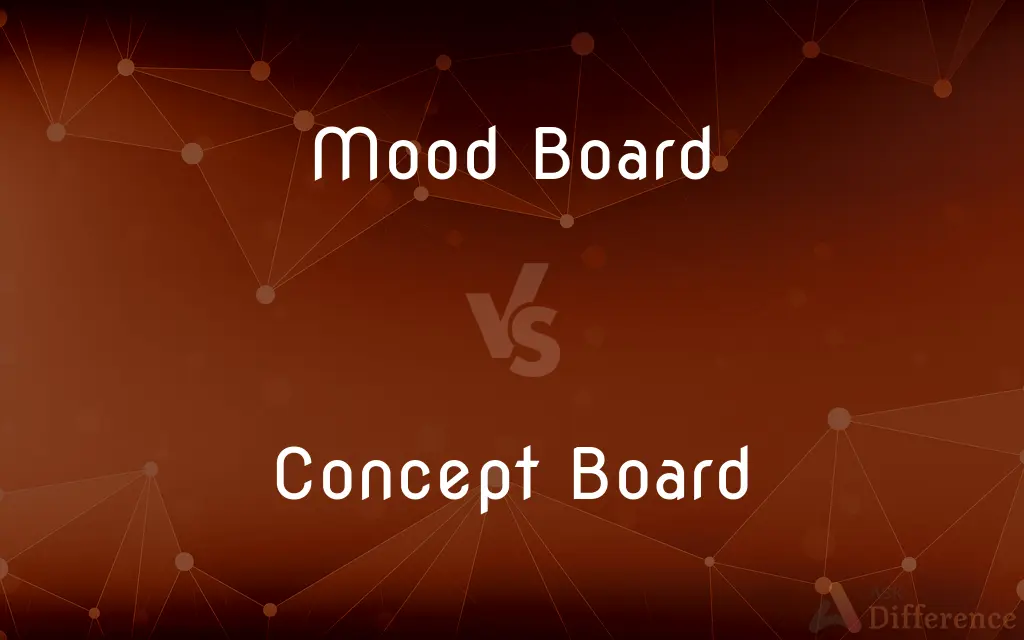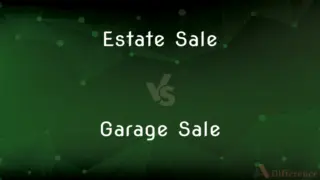Mood Board vs. Concept Board — What's the Difference?
By Tayyaba Rehman & Fiza Rafique — Published on March 20, 2024
Mood boards capture the essence and emotional tone of a project through imagery and materials, while concept boards present a clear idea or theme with specific examples and directions.

Difference Between Mood Board and Concept Board
Table of Contents
ADVERTISEMENT
Key Differences
Mood boards are primarily used to convey the emotional tone, feel, and general aesthetic of a project. They consist of a collage of images, materials, colors, and textures. These boards are subjective and aim to evoke a specific feeling or mood among viewers, often used in the early stages of design to capture and communicate the intended atmosphere.
Concept boards, on the other hand, focus on the concrete ideas, themes, and directions of a project. They provide a more straightforward and detailed representation of the project's goals, including specific examples of elements to be used, such as colors, typography, and imagery. Concept boards are objective and serve as a roadmap for the project, outlining clear ideas and solutions.
Mood boards are abstract and open to interpretation, while concept boards are precise and informative. The former is about creating a sensory experience, whereas the latter is about defining a strategic direction. This difference highlights the contrast between emotional engagement and conceptual clarity.
The creation process also differs; mood boards allow for a freer, more exploratory approach, gathering inspiration from a wide range of sources. Concept boards require a more analytical method, selecting elements that align with the project's specific objectives and requirements.
In use, mood boards help to align the project team and stakeholders on the emotional direction, ensuring everyone shares the same vision. Concept boards, however, are used to make decisions about the project's practical aspects, guiding the development and implementation phases with specific examples and guidelines.
ADVERTISEMENT
Comparison Chart
Purpose
To evoke an emotional response and set a tone
To define and communicate specific ideas
Content
Imagery, colors, textures
Specific examples, colors, typography
Focus
Emotional tone and feel
Concrete ideas and themes
Interpretation
Subjective and open
Objective and straightforward
Use Stage
Early, for inspiration
Later, for direction and decision-making
Compare with Definitions
Mood Board
A visual presentation of colors, textures, and images assembled to evoke a specific style or concept.
The designer's mood board featured ocean colors to evoke calmness for the spa's branding.
Concept Board
A presentation that combines specific examples and elements to define a project's theme.
The concept board illustrated the architectural style and materials for the new building.
Mood Board
A tool to explore and convey emotional undertones of a design project.
Her mood board captured the essence of luxury with gold and black palettes.
Concept Board
A board that communicates the concrete elements of a design, such as colors and typography.
The concept board for the website redesign showcased the new color scheme and font choices.
Mood Board
A collage used by designers to communicate the aesthetic feel of a project.
The mood board for the café included warm tones and rustic textures.
Concept Board
A visual representation that outlines the specific ideas and strategies of a project.
The concept board clearly outlined the minimalist theme for the hotel's interior.
Mood Board
An inspirational board used to gather ideas and feelings.
The mood board was filled with images of nature to inspire the eco-friendly packaging design.
Concept Board
A tool used for decision-making, presenting clear directions and choices.
The concept board presented three thematic options for the marketing campaign.
Mood Board
A method to visually communicate the mood of a campaign.
The advertising team created a mood board with vibrant colors to represent energy and youth.
Concept Board
A detailed visual guide that conveys the thematic direction of a project.
The concept board for the fashion line included fabric samples and color palettes.
Mood Board
(ambitransitive) To create a mood board of something.
Common Curiosities
How does a concept board differ from a mood board in content?
A concept board includes specific examples and elements like colors and typography, while a mood board uses imagery and materials to evoke feelings.
When is a concept board most useful?
During the planning and decision-making phases, to communicate and refine specific project ideas and themes.
Can mood boards and concept boards be used together?
Yes, they can complement each other by setting the emotional tone (mood board) and defining specific ideas (concept board) for a project.
What role do concept boards play in project development?
They provide a clear roadmap and guide the selection of concrete design elements and strategies.
What is the main purpose of a mood board?
To evoke an emotional response and set the aesthetic tone of a project.
What makes a mood board subjective?
Its purpose is to evoke feelings, which can vary widely among different viewers.
When should a mood board be used?
In the early stages of a project, for inspiration and to establish the emotional direction.
What is the objective nature of a concept board?
It presents clear, defined ideas and elements that guide the project's direction.
How do mood boards help in design projects?
They ensure all stakeholders share the same emotional vision and aesthetic direction.
Can a concept board include materials and textures?
Yes, but they are chosen to illustrate specific ideas and themes, unlike the more exploratory nature of mood boards.
Share Your Discovery

Previous Comparison
Benzyl Chloride vs. Benzoyl Chloride
Next Comparison
Estate Sale vs. Garage SaleAuthor Spotlight
Written by
Tayyaba RehmanTayyaba Rehman is a distinguished writer, currently serving as a primary contributor to askdifference.com. As a researcher in semantics and etymology, Tayyaba's passion for the complexity of languages and their distinctions has found a perfect home on the platform. Tayyaba delves into the intricacies of language, distinguishing between commonly confused words and phrases, thereby providing clarity for readers worldwide.
Co-written by
Fiza RafiqueFiza Rafique is a skilled content writer at AskDifference.com, where she meticulously refines and enhances written pieces. Drawing from her vast editorial expertise, Fiza ensures clarity, accuracy, and precision in every article. Passionate about language, she continually seeks to elevate the quality of content for readers worldwide.














































